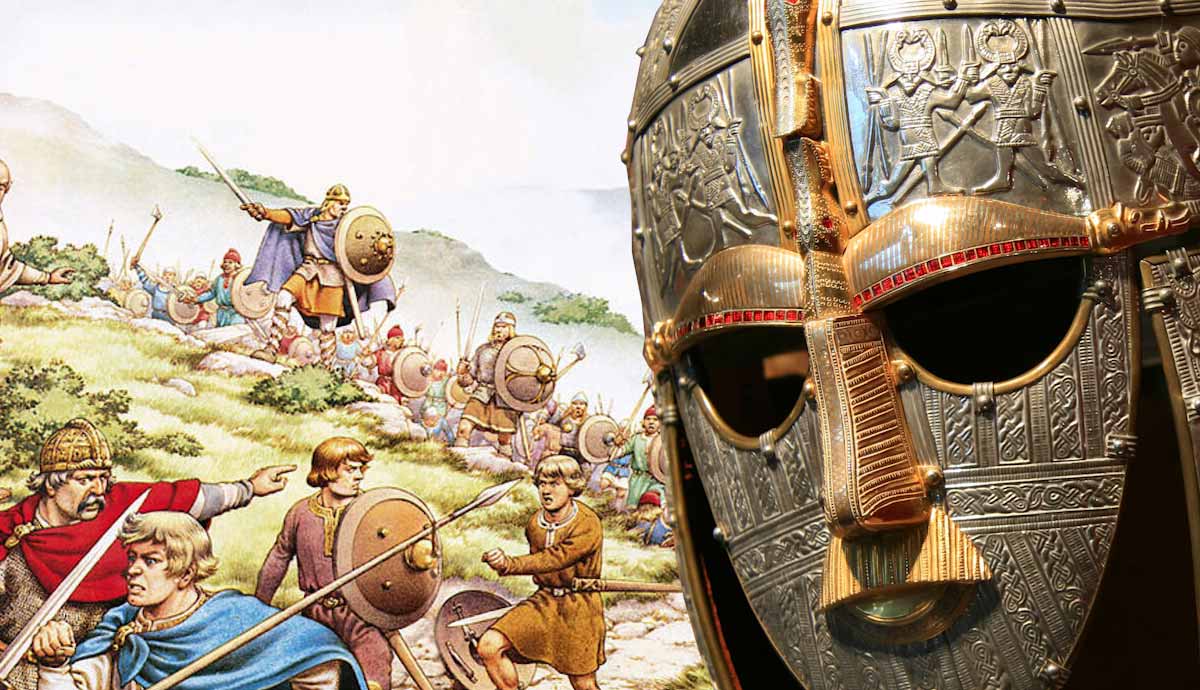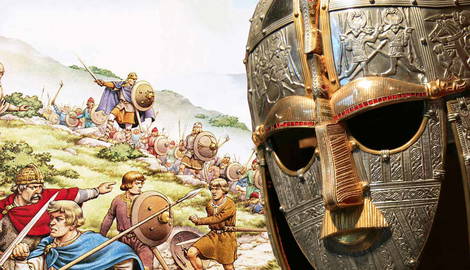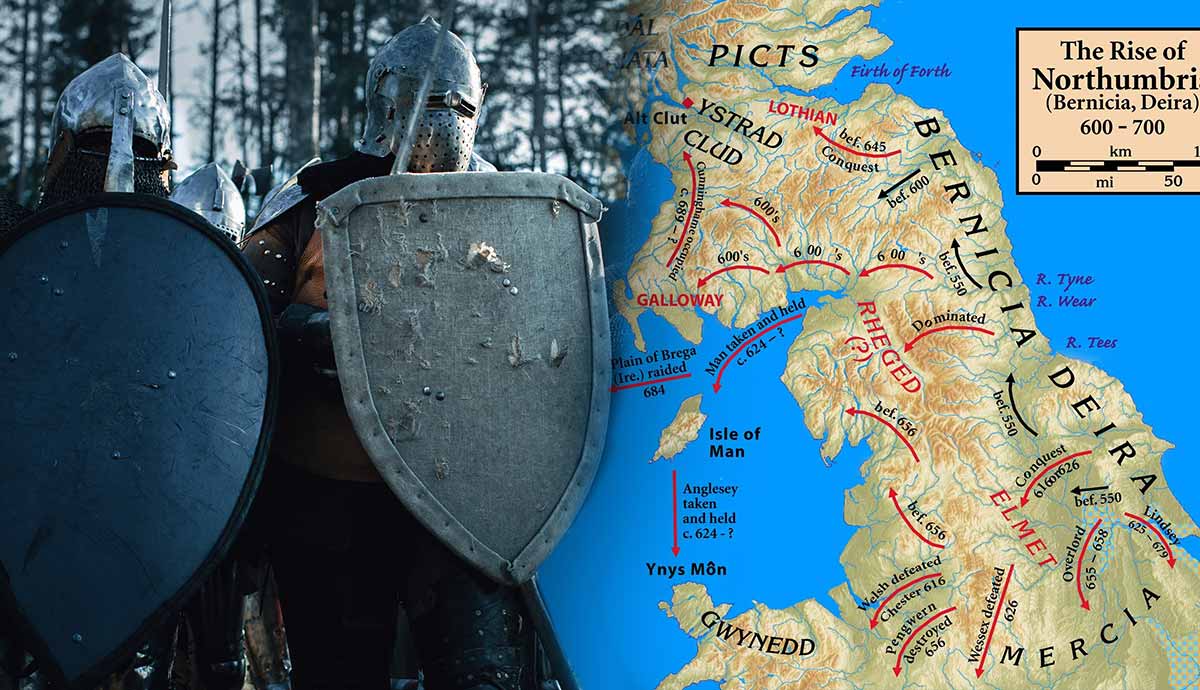
During early Dark Age Britain, a major transition occurred. In the early 5th century, just after the Roman administration was driven out in 409, Britain was predominantly an ethnically Brythonic island. It was inhabited by the Britons, although they were largely Roman in culture by that point. However, by about the year 700, the Anglo-Saxons had conquered most of what is now England. Britain had become a predominantly Germanic country. This was a massive change that had a profound impact on the rest of the history of the island. But how did this massive transition take place?
A Thorough Beginning

Many people imagine the Anglo-Saxons to have started from the southeast corner of Britain and spread out from there. This idea partially comes from the legend of King Vortigern giving the Anglo-Saxons the Isle of Thanet in Kent in exchange for their service as mercenaries. This legend certainly has a factual basis, but it was not limited to the Isle of Thanet. The arrival of the Anglo-Saxon mercenaries in Britain is described by Gildas, a writer of the 6th century. He explained:
“They first landed on the eastern side of the island, by the invitation of the unlucky king [Vortigern], and there fixed their sharp talons, apparently to fight in favor of the island.”

Notice that Gildas simply says that they landed on “the eastern side of the island.” He does not suggest that they were limited to one small corner. After all, they were hired to help deal with raids from the Picts and the Scots, who usually came from the north. Archaeology confirms the presence of the Anglo-Saxons as far north as York from almost their very earliest presence on the island.
Speedy Progress

From this strong initial position, it was not too difficult for the Anglo-Saxons to start gaining more territory. Rather than needing to spread out from a tiny corner in the southeast, they spread out from most of the eastern side of what is now England. How quickly did they advance to the West? Again, the answer to this question differs from what most people assume. Their initial advance appears to have been very fast. Again, notice what Gildas explains:
“For the fire of vengeance… spread from sea to sea, fed by the hands of our foes in the east, and did not cease, until, destroying the neighboring towns and lands, it reached the other side of the island, and dipped its red and savage tongue in the western ocean.”
According to this, the advance of the Anglo-Saxons went right across to the other side of the island. This passage describes events from before the campaigns of Ambrosius Aurelianus, who seems to have been active from the 470s onwards.

This would suggest that the Anglo-Saxons had managed to advance as far as the western sea before the 470s. Since the conquest of Britain started in about 430, this was a very quick advance. Why is it, then, that most modern sources speak as if the Anglo-Saxons did not get anywhere near Wales until 570 or even later? The reason is evidently because those sources are referring to areas in which the Anglo-Saxons established permanent settlements. Yet, armies can and often do travel much further than the settlements from which they originate, and in doing so, they often leave no archaeological trace. For example, Julius Caesar’s two incursions into Britain left virtually no archaeological evidence.
In terms of permanent settlements, the Saxons established themselves as far west as Dorchester-on-Thames by at least as early as 450. Undoubtedly, their raids went beyond that. It is not unrealistic in the slightest to conclude that their armies reached the Severn Sea and even modern-day Wales. This is heavily supported by Gildas’ near-contemporary record.
How the Anglo-Saxons Suffered a Reversal

Clearly, the Anglo-Saxons made very effective progress for the first few decades of their conquest. However, the tide eventually turned against them. Ambrosius Aurelianus led an effective counter-offensive against them from the 470s onwards. His career likely ended around 500. According to legend, he was succeeded by Uther Pendragon, the father of King Arthur; after him came Arthur himself, in the first half of the 6th century.
The actual history concerning these figures is obviously fiercely debated, and it is not worth getting into that here. Nonetheless, what we do know is that the archaeological record attests to a cessation of Anglo-Saxon advances throughout much of the 6th century. There are even indications of a reversal. Two continental sources, one of them contemporary, attest to the fact that the Anglo-Saxons were actually leaving Britain in the period between 530 and 550 CE. This reverse migration is strong evidence of the Britons effectively fighting against them in that era.
The Tide Turns Again

However, the Britons did not hold the Anglo-Saxons back for long. The Anglo-Saxon Chronicle, written in the 10th century, attests to a sudden advancement to the west in 577. Naturally, the fact that this document was written hundreds of years after the fact leaves open the possibility that it is inaccurate. Nonetheless, the lack of advances through a significant portion of the 6th century, demonstrated by archaeology, is accurately reflected in this chronicle. Therefore, the entry regarding 577 is likely historically valuable.
According to this entry, the Battle of Dyrham took place this year. Dyrham is a village in southern Gloucestershire, just north of Bath. As a result of their victory at this battle, the Anglo-Saxons took control of three important cities: Bath, Gloucester, and Cirencester. This was a major event. This essentially divided the Brythonic territory centered on what is now Wales from the Brythonic territory of Cornwall and Devon.
In recent years, some researchers have argued that this was not significant because the two territories were easily connected by means of traversing the Severn Sea, which was like a highway. The simple fact, though, is that Wales did develop separately to the West Country, and the reason was the Battle of Dyrham.
The Fateful Battle of Chester

Warfare between the Britons and the Anglo-Saxons continued for the next few decades. The latter continued to grow more powerful. In the early 7th century, another major battle occurred which helped to reinforce Anglo-Saxon supremacy over the island. This was the Battle of Chester, which is usually placed in 616 or a few years before. The earliest surviving source for this battle is Bede, writing in the 8th century. His account, although not contemporary, is close enough to be very valuable.
From Bede’s account and later sources, we know that the main Anglo-Saxon leader at this battle was Aethelfrith, king of Northumbria. He was expanding his kingdom towards what is now Wales. He clashed with the armies of the Britons at Chester, near the eastern border of present-day Wales. The Britons were defeated. At this battle, the Anglo-Saxons killed Selyf son of Conan Garwyn, likely the Aurelius Caninus mentioned by Gildas in De Excidio. He was the king of Powys, the kingdom making up most of the eastern portion of Wales. There is also some evidence that King Morgan of Glywysing and Gwent was involved in this battle.
Losses Throughout the 7th Century

Even though the Kingdom of Northumbria had pushed as far as Chester, essentially marking the modern border of Wales, the Brythonic kingdom of Elmet was still a thorn in its side. Its exact borders are unknown, but it was likely southwest of York, much further east than Wales. The king of this kingdom in the early 7nth century was Ceretic. He became a figure of Welsh legend. He appears in the Historia Regum Britanniae, written by Geoffrey of Monmouth in c. 1137, as one of the last Brythonic kings still standing against the Anglo-Saxon kingdoms. In about 619, King Edwin of Northumbria invaded Elmet and drove out Ceretic.
With this victory, the Anglo-Saxons controlled the major part of what is now England. Territory in the northeast was still fought over, and it would take quite some time for the Germanic conquerors to gain control over every bit of modern-day England. Nonetheless, after these victories in the early 7th century, the Anglo-Saxons had well and truly gained supremacy over the Britons.
How the Britons Were Surpassed by the Anglo-Saxons

The Anglo-Saxons were ironically given a very good start to their conquest, due to the Britons handing them a large portion of the eastern side of Britain. Within just a few decades, they had conquered a considerable amount of territory and had raided as far as the western sea, likely meaning the Severn Sea.
During the career of Ambrosius Aurelianus and his successors, starting in the 470s, the Anglo-Saxons were driven back to a degree. Yet, this changed again in the 570s. In about 577, the Anglo-Saxons suddenly made rapid progress to the west, conquering the cities of Bath, Gloucester, and Cirencester. This led to Wales and the West Country developing independently. By 616, the Kingdom of Northumbria had expanded significantly. It clashed against the Kingdom of Powys and likely other British territories, which it defeated at the Battle of Chester. Just a few years later, Northumbria defeated Elmet, the last remaining Brythonic kingdom in the heart of what is now England.










